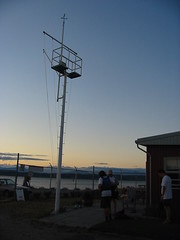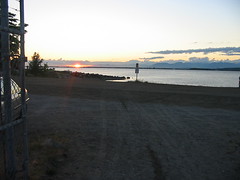
Lookout Mast - The 'crows nest' in front of the clubhouse. We were taught to always check the windvane at the top so we know the direction of the wind.
Originally uploaded by Allan & Cheryl
One of the things that seems to trip up a lot of people when they are learning to sail is all the new terminology. I say terminology instead of jargon because jargon really means using words to obfuscate instead of to communicate. When sailing with more than one person (which is more often the case), communication is crucial.
To be fair, one must consider the factors that make all the sailing language (and I don't mean the cussing, even though sailors are famous for that too) necessary. Firstly, the water (and water-borne vessels) is a completely different environment than landlubbers are used to. New terms are needed to describe the things that waves, winds, and boats do. Secondarily, people have been sailing for a very long time. Consequently we have many sailing traditions and terms surrounding the same sailing concepts.

Sailing Dinghies - A couple of boats in our Pirate fleet
Originally uploaded by Allan & Cheryl
Tonight my sailing classmates and I continued our initiation into the world of sailing traditions and terms. We spent the first 1/2 hour learning more about why it is important to always know where the wind is coming from (it determines things like if you can move or not) and what to call it when our boats are pointed towards, across, or away from the wind (the points of sail).
When your boat is pointed at the wind, it can't push your sails, and consequently you don't move. This is called being 'in irons'.
When your boat is pointed directly away from the wind, it's called running free. You set your sails way out to one side or the other so the wind can push on them and drive your boat forward. The downside to this is that the air is pushing on the front of your sail too, so you can only go as fast as the wind is moving.
When your boat is pointed towards the wind, but partly to the right or to the left, it's called close-hauled. You set your sails so the wind can push on them at an angle, but they have to be tensioned firmly for the wind to be used effectively.
Modern sailboats can only sail up to 45 degrees off the wind. If you try and point closer to the wind than that, you slow down very quickly, and it's pretty close to being in irons. This 90 degree span is called the 'no sail zone'.
When your boat is pointed across the wind or away from the wind, either to the right or left, it's called reaching. You set your sails so the wind can push on them at an angle and they can move your boat pretty quickly in any of these positions.

Sunset after class - The sun sets between the masts of our sailing dinghies.
Originally uploaded by Allan & Cheryl
The next step is to understand that when you change the direction your boat is pointed at, you have to reset the angle your sails are set at so the wind can push on them the most effectively.
If you are close-hauled - moving towards the wind towards the right - and you turn your boat so it is pointing towards the wind towards the left, this is called changing tacks. Moving upwind zig-zag-ing back and forth across the wind is called tacking (or beating to windward in some tradtions).
If you are reaching - moving away from the wind - and you change directions, it's called gybing (or jibing).
Having absorbed all of the above, we took a pair of boats down to the water and spent time with our instructors learning how to position ourselves, the sails, and the lines when our boats are changing directions. There seemed to be an awful lot to absorb, but it always seems so when you're learning something new. I am sure that in time, things like remembering to stay close to the thwart so you have enough room to not get tangled up with the tiller extension will become second nature.
All of which brings us to the title of this commentary! Of the changes in direction you can take your boat through, the two that take the most practice are when you tack or gybe. Tacking is actually not too bad because what you are doing is crossing the no sail zone from one side to the other and your boat naturally slows down a bit, which gives you the time you need to shift yourself from one side of the boat to the other, switch which hand is controlling the tiller, which hand is controlling the mainsail sheet, all the while ducking as the boom and mainsail shift to the side you were just sitting on. Gybing is tougher because you have to do the same thing, but with the added pressure of the wind on the sail. The pressure of the wind can often cause the boom to swing quickly and unexpectedly from one side of the boat to the other. If you don't pay mind, you usually treated to a nasty whack on the head!

Crescent Beach Sunset - In the middle distance is the beach where we launch our boats. We don't have our own dock, but the water's quite shallow anyhow.
Originally uploaded by Allan & Cheryl
Anyhow, if you manage to get the hang of tacking and gybing, you are apparently well on your way to becoming a proper sailor.
This evening our instructors took each of us out one at a time, for our first shot at boat handling and sail handling. All of the stuff I mentioned above was what we practiced, first as a crew person managing the jib sail, then as the skip managing the tiller and mainsail. Overall our class did very well. Only one person capsized their boat and that was because they got caught by a surprise gust of wind just as they were practicing a tacking manoever that got out of hand. No one laughed, since we had all been a little shaky ourselves. Instead we all cheered as Mike, the instructor, managed to right the boat again - without having been tossed into the saltchuck himself! - reset the sails, and brought the boat back around to pick-up the man overboard.
I was the last person to go out and Geoff let me take the helm after about 5 minutes! Oh boy was I nervous - especially since the wind had been getting more gusty as the evening wore on. The good news is that Geoff coached me through a few gusts and I got the hang of it enough that we didn't get knocked over like poor Calvin had. The bad news was that we ran out of light pretty quickly so I'll have to wait until next Tuesday before I can try my hand at the helm again.


1 comment:
Hmmm, I'm beginning to see how this could quickly become addicting!
GMP
Post a Comment